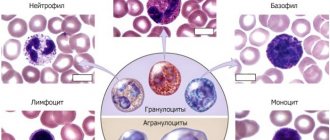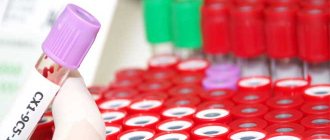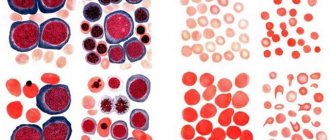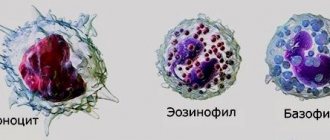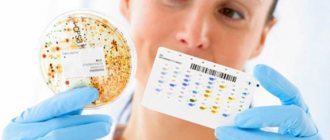Granulocytes are a group of white cells that contain granules in their cytoplasm. They are also called granular leukocytes. Granulocytes include neutrophils, basophils and eosinophils. They make up about 60% of all white blood cells. The most numerous group is neutrophil granulocytes, the least in the blood are basophils.
These cells are produced in the bone marrow from precursor cells, which divide within four days, then morphological maturation occurs, which takes five days. As soon as granulocytes enter the bloodstream, they are immediately divided into parietal (temporarily adhering to the walls of blood vessels) and actively circulating. They remain in the blood for about one week, and after release into the tissue they live for about two days.
Granulocytes contain a large number of granules in the cytoplasm, which is why the cells got their name
Types of granulocytes
Granulocytes are divided into neutrophilic, basophilic and eosinophilic depending on how they perceive standard dyes. The size of these cells is 9-12 microns.
Neutrophils are the most numerous group of granular leukocytes. Their name is due to the fact that according to the Romanovsky method they are stained with both a basic dye and an acidic dye (eosin). Mature neutrophil granulocytes are polymorphonuclear cells because their nucleus consists of four to five segments. In the blood of a healthy person, mainly mature segmented forms and a small number of band granulocytes circulate.
Eosinophils get their name due to the fact that they stain only with an acidic dye (eosin) and do not absorb the basic one. Their core consists of two lobes.
Basophilic granulocytes are intensely stained only with basic dye and do not perceive acidic dye, which is why they got their name. These granular leukocytes are characterized by a high content of histamine, prostaglandins, heparin, serotonin and others. Their core is vague, structureless, and usually consists of two segments. It is difficult to see due to the large number of histamine granules in the cytoplasm.
Functions of neutrophils
Neutrophils are capable of active movement and can move outside the blood vessels. Mostly they move to the site of inflammation. Neutrophils can carry out phagocytosis, but are able to absorb only small particles, so they are classified as microphages. After absorption of foreign cells, they die, and a large number of active substances are released, which lead to damage to harmful microorganisms, enhance inflammatory processes and the movement of immune cells to the site of infection.
From neutrophils, tissues destroyed as a result of inflammation, and microorganisms that caused this process, a mass is formed, which is known to everyone as pus. The main function of these granulocytes is protection against fungal and bacterial infections. They protect significantly less against viruses and do not take part in protection against helminths and tumors. In acute bacterial infections, the very first immune response is neutrophilic. It is always ahead of the specific lymphocytic one. At the same time, in chronic processes the role of neutrophils is small; in this case, the lymphocytic response predominates.
Functions of basophils
The main function of basophils is to participate in the formation of an immediate allergic reaction, an example being anaphylactic shock. They instantly react to insect and snake bites, blocking their venom and preventing it from spreading throughout the body. There are other functions of basophilic granulocytes. They participate in the regulation of blood clotting thanks to the heparin found in their cytoplasm. On their surface, basophils carry immunoglobulin E; they can release the contents of granules into the external environment and dissolve cells upon contact with an allergen. When cells degranulate and dissolve, large amounts of histamine, prostaglandins, serotonin, leukotrienes and other bioactive substances are released. As a result, an allergic reaction to the allergen that has entered the body is observed. Basophils can penetrate and live outside of blood vessels. They are capable of phagocytosis, although this function is not natural for them. Their main purpose is instant degranulation, which increases blood flow, increases vascular permeability, ensures fluid flow and attracts other granulocytes to the site of inflammation.
Neutrophils
Neutrophil granulocytes represent the most numerous group and make up 45-75% of the total number of white blood cells. Segmented and band forms are found in the peripheral blood of a healthy person. Segmented granulocytes have a large amount of cytoplasm and a small nucleus, which is divided into 5-6 segments. Band granulocytes belong to younger forms of leukocytes, having a horseshoe-shaped or S-shaped nucleus, their number is no more than 6%. In the blood of a child in the first year of life, the content of leukocytes with a band nucleus can reach 20%, which is a physiological variant of the norm. With age, the number of rods gradually decreases.
The main function of cells is considered to be the process of phagocytosis - searching, capturing and digesting foreign agents (bacteria, tumors, viruses, protozoa). Numerous granules in neutrophils contain hydrolase, myelopyroxidase, and lysozyme, which destroy pathogenic particles and are an important part of cellular immunity. As a result, pus is formed at the site of inflammation, consisting of destroyed tissue cells, granulocytes, infectious agents, and inflammatory fluid.
The maturation of neutrophil leukocytes in the bone marrow occurs in 9-12 days, after which they enter the blood, where they circulate for no more than 10 hours. The main function of cells is carried out in tissues affected by infectious agents, parasites, and tumors. The appearance of immature granulocytes, such as myeloblasts, promyelocytes, metamyelocytes, and myelocytes in the peripheral blood indicates the development of a pathological process in the body.
View of neutrophils under a microscope
A decrease in the concentration of neutrophils in the blood is called neutropenia (less than 1.7 * 109/l) and occurs in the following cases:
- radiation sickness;
- bone marrow tumors (acute and chronic leukemia, primary myelofibrosis);
- aplastic, iron deficiency anemia;
- rickettsiosis (typhoid fever);
- viral infections (flu, hepatitis, rubella, AIDS);
- parasitic infestations (malaria);
- bacterial infections (tularemia, typhoid, brucellosis);
- autoimmune pathology (collagenosis, lupus erythematosus);
- exhaustion of the body (chronic alcoholism, cachexia);
- enlarged spleen (hypersplenism);
- taking toxic medications (tranquilizers, immunosuppressants, non-hormonal anti-inflammatory drugs, antibiotics).
An infant may experience congenital neutropenia - Kostman's syndrome, which is a disease with an autosomal recessive inheritance mechanism. As a result of insufficient formation of neutrophils in the bone marrow, chronic foci of infection develop on the skin and internal organs, which can lead to death due to insufficient functioning of cellular immunity.
Functions of eosinophils
Eosinophilic granulocytes are able to actively move and penetrate beyond the bloodstream. They can be called phagocytes, although phagocytosis is not their main function. They can only absorb small cells, so they are classified as microphages. They have cytotoxic properties, so their main function is to participate in antiparasitic immunity. They absorb and bind histamine and other mediators of inflammation and allergies. Like basophils, they can release these substances. Thus, eosinophilic granulocytes are capable of both suppressing an allergic reaction and performing a pro-allergic function.
Basophils increase in the blood during allergies
Normal granulocytes
The content of granulocytes is determined during a general blood test, both absolute and relative quantities are calculated.
The norm of granulocytes for adult men and women is from 1.2 to 6.8X10⁹ per liter of blood. Relative content (percentage of the total number of leukocytes) – from 47 to 72%.
Elevated granulocytes during pregnancy are considered a physiological norm, but if their level is high and continues to increase, there is a high probability of developing pathology. You can read about the reasons for the increase in white blood cells during pregnancy here.
The norm for children may differ under the age of 12 years. This is especially true for the percentage of certain types of granulocytes. After 12 years, the norm for a child is the same as for adults.
Possible reasons for deviation from the norm
The reasons for the increase in the number of white cells in the blood may be the following:
- parasitic infections;
- acute inflammatory processes;
- infectious diseases;
- pathological processes that are accompanied by tissue necrosis;
- allergic reactions;
- intoxication of the body;
- acute hemorrhages;
- diseases of the hematopoietic system;
- oncological diseases;
- inflammatory processes in the gastrointestinal tract;
- Hodgkin's syndrome;
- endocrine disorders;
- diseases of the cardiovascular system;
- hemolytic anemia;
- infectious processes of non-parasitic nature.
Taking certain medications can also cause granulocytes in the blood to be higher than normal. As a rule, after stopping the medications, the indicators return to normal.
The reasons that granulocytes in the blood are below normal are as follows:
- Myelocytes in the blood: causes and treatment
- allergic reactions;
- gastroenterological diseases;
- systemic or autoimmune diseases;
- various types of anemia;
- scarlet fever;
- rheumatism;
- sarcoidosis
It should also be taken into account that when interpreting the analysis, other blood parameters are also taken into account, so it is not recommended to interpret the data yourself: only a doctor can do this correctly.
Why are granulocytes elevated?
The reasons for the increase in granulocytes may be different. Most often they are elevated due to inflammatory processes occurring in the body. The most common include:
- acute infectious diseases;
- parasitic infections;
- diseases accompanied by necrotic processes;
- intoxication;
- malignant tumors;
- recent infectious disease;
- vaccinations;
- taking certain medications;
- allergies.
Neutrophilia is caused by the following factors:
- acute bacterial infections;
- endogenous and exogenous intoxications;
- acute hemorrhages;
- myeloproliferative diseases;
- taking medications.
This is what neutrophilia looks like on a blood smear
Eosinophilia indicates the development of:
- parasitic diseases;
- allergic reactions;
- tumors;
- non-parasitic infections;
- skin diseases;
- immune diseases;
- endocrine disorders;
- heart pathologies;
- systemic connective tissue diseases.
Causes of basophilia:
- ulcerative colitis and other gastrointestinal inflammations;
- Hodgkin's syndrome;
- allergy;
- blood diseases;
- hemolytic anemia;
- taking medications.
Immature granulocytes are increased
When neutrophils increase, the leukocyte count often tends to shift to the left. Thus, we can talk about the presence of immature and band granulocytes. This means that a pathological inflammatory process develops in the body. In this regard, the production of these leukocytes begins in the required volumes in order to protect a person from infections. Therefore, it can be observed from the analyzes that immature granulocytes are increased. Their level also increases during physiological processes:
- during pregnancy,
- in stressful situations,
- after eating food,
- during physical activity.
If a child in infancy has an increased level of granulocytes in the blood, then do not panic, as this is the norm.
- If immature granulocytes are elevated, what does this mean?
Increased values of young granulocytes can be observed if the following pathological conditions are present:
- pneumonia, appendicitis, purulent-necrotic processes in the bones, inflammation of the meninges, kidney disease, cholera, sepsis, tonsillitis, thrombophlebitis, cholecystitis, scarlet fever, otitis media,
- purulent processes: abscess and phlegmon,
- typhoid fever, tuberculosis, hepatitis, malaria, measles, influenza, rubella,
- chronic skin diseases: psoriasis, some types of dermatitis,
- acute bleeding,
- burns,
- intoxication of various etiologies: lead poisoning, mosquito bites, etc.,
- malignant formations,
- systemic diseases,
- gout,
- myocardial infarction, pulmonary infarction,
- gangrene,
- chronic myeloplastic diseases,
- serum sickness,
- after using certain medications.
The most dramatic shift to the left can be observed with the development of myelomonocytic leukemia and purulent process. You can also observe qualitative changes, often with intoxication, purulent and inflammatory lesions, however, with a stroke, burn, heart attack and trophic ulcer, neutrophils rarely increase. Thus, high rates should be alarming.
